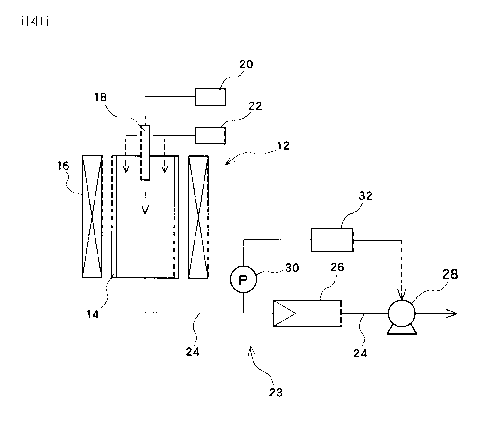Une partie des informations de ce site Web a été fournie par des sources externes. Le gouvernement du Canada n'assume aucune responsabilité concernant la précision, l'actualité ou la fiabilité des informations fournies par les sources externes. Les utilisateurs qui désirent employer cette information devraient consulter directement la source des informations. Le contenu fourni par les sources externes n'est pas assujetti aux exigences sur les langues officielles, la protection des renseignements personnels et l'accessibilité.
L'apparition de différences dans le texte et l'image des Revendications et de l'Abrégé dépend du moment auquel le document est publié. Les textes des Revendications et de l'Abrégé sont affichés :
| (12) Demande de brevet: | (11) CA 2700605 |
|---|---|
| (54) Titre français: | APPAREIL DE PRODUCTION ET APPAREIL DE RECUPERATION DE NANOTUBES DE CARBONE OU DE NANOFIBRES DE CARBONE |
| (54) Titre anglais: | CARBON NANOTUBE OR CARBON NANOFIBER PRODUCTION APPARATUS AND RECOVERY APPARATUS |
| Statut: | Réputée abandonnée et au-delà du délai pour le rétablissement - en attente de la réponse à l’avis de communication rejetée |
| (51) Classification internationale des brevets (CIB): |
|
|---|---|
| (72) Inventeurs : |
|
| (73) Titulaires : |
|
| (71) Demandeurs : |
|
| (74) Agent: | GOWLING WLG (CANADA) LLP |
| (74) Co-agent: | |
| (45) Délivré: | |
| (86) Date de dépôt PCT: | 2008-10-16 |
| (87) Mise à la disponibilité du public: | 2009-07-02 |
| Licence disponible: | S.O. |
| Cédé au domaine public: | S.O. |
| (25) Langue des documents déposés: | Anglais |
| Traité de coopération en matière de brevets (PCT): | Oui |
|---|---|
| (86) Numéro de la demande PCT: | PCT/JP2008/068786 |
| (87) Numéro de publication internationale PCT: | JP2008068786 |
| (85) Entrée nationale: | 2010-03-22 |
| (30) Données de priorité de la demande: | ||||||
|---|---|---|---|---|---|---|
|
Un rejet gazeux contenant des nanotubes de carbone et évacué d'un réacteur (12) est amené à un filtre (26) par l'intermédiaire d'une conduite d'évacuation (24). Un ventilateur (28) est disposé en aval du filtre (26). Le ventilateur (28) est utilisé pour aspirer le rejet gazeux dans la conduite d'évacuation (24). Ainsi, même lorsque le filtre a commencé à se boucher, la pression à l'intérieur de la conduite d'évacuation, du coté amont du filtre, ne peut pas augmenter.
A discharge gas containing carbon nanotubes and discharged
from a reactor (12) is led to a filter (26) through a
discharge pipe (24). A blower (28) is disposed downstream
from the filter (26). The blower (28) is used to suck the
discharge gas in the discharge pipe (24). Thus, even when
the filter has begun to clog, the pressure inside the
discharge pipe on the side upstream from the filter is
inhibited from increasing.
Note : Les revendications sont présentées dans la langue officielle dans laquelle elles ont été soumises.
Note : Les descriptions sont présentées dans la langue officielle dans laquelle elles ont été soumises.

2024-08-01 : Dans le cadre de la transition vers les Brevets de nouvelle génération (BNG), la base de données sur les brevets canadiens (BDBC) contient désormais un Historique d'événement plus détaillé, qui reproduit le Journal des événements de notre nouvelle solution interne.
Veuillez noter que les événements débutant par « Inactive : » se réfèrent à des événements qui ne sont plus utilisés dans notre nouvelle solution interne.
Pour une meilleure compréhension de l'état de la demande ou brevet qui figure sur cette page, la rubrique Mise en garde , et les descriptions de Brevet , Historique d'événement , Taxes périodiques et Historique des paiements devraient être consultées.
| Description | Date |
|---|---|
| Inactive : CIB expirée | 2017-01-01 |
| Demande non rétablie avant l'échéance | 2013-10-16 |
| Le délai pour l'annulation est expiré | 2013-10-16 |
| Réputée abandonnée - omission de répondre à un avis sur les taxes pour le maintien en état | 2012-10-16 |
| Inactive : IPRP reçu | 2010-09-28 |
| Inactive : Page couverture publiée | 2010-06-01 |
| Inactive : Notice - Entrée phase nat. - Pas de RE | 2010-05-19 |
| Demande reçue - PCT | 2010-05-19 |
| Inactive : CIB en 1re position | 2010-05-19 |
| Inactive : CIB attribuée | 2010-05-19 |
| Inactive : CIB attribuée | 2010-05-19 |
| Exigences pour l'entrée dans la phase nationale - jugée conforme | 2010-03-22 |
| Demande publiée (accessible au public) | 2009-07-02 |
| Date d'abandonnement | Raison | Date de rétablissement |
|---|---|---|
| 2012-10-16 |
Le dernier paiement a été reçu le 2011-08-24
Avis : Si le paiement en totalité n'a pas été reçu au plus tard à la date indiquée, une taxe supplémentaire peut être imposée, soit une des taxes suivantes :
Les taxes sur les brevets sont ajustées au 1er janvier de chaque année. Les montants ci-dessus sont les montants actuels s'ils sont reçus au plus tard le 31 décembre de l'année en cours.
Veuillez vous référer à la page web des
taxes sur les brevets
de l'OPIC pour voir tous les montants actuels des taxes.
| Type de taxes | Anniversaire | Échéance | Date payée |
|---|---|---|---|
| Taxe nationale de base - générale | 2010-03-22 | ||
| TM (demande, 2e anniv.) - générale | 02 | 2010-10-18 | 2010-08-18 |
| TM (demande, 3e anniv.) - générale | 03 | 2011-10-17 | 2011-08-24 |
Les titulaires actuels et antérieures au dossier sont affichés en ordre alphabétique.
| Titulaires actuels au dossier |
|---|
| NIKKISO CO., LTD. |
| Titulaires antérieures au dossier |
|---|
| SHUICHI SHIRAKI |
| TAKEJI MURAI |
| YUZOU NAKAGAWA |